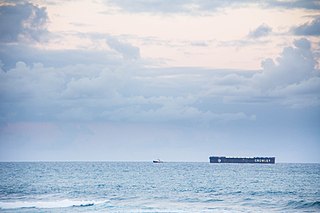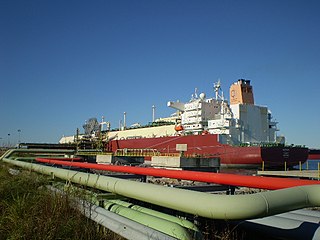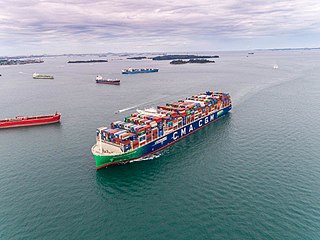Cryogenic fuels are fuels that require storage at extremely low temperatures in order to maintain them in a liquid state. These fuels are used in machinery that operates in space where ordinary fuel cannot be used, due to the very low temperatures often encountered in space, and the absence of an environment that supports combustion. Cryogenic fuels most often constitute liquefied gases such as liquid hydrogen.

Liquefied natural gas (LNG) is natural gas (predominantly methane, CH4, with some mixture of ethane, C2H6) that has been cooled down to liquid form for ease and safety of non-pressurized storage or transport. It takes up about 1/600th the volume of natural gas in the gaseous state (at standard conditions for temperature and pressure).

A Natural Gas Vehicle (NGV) is an alternative fuel vehicle that uses compressed natural gas (CNG) or liquefied natural gas (LNG). Natural gas vehicles should not be confused with auto gas vehicles powered by liquefied petroleum gas (LPG), mainly propane, a fuel with a fundamentally different composition.

Wärtsilä Oyj Abp, trading internationally as Wärtsilä Corporation, is a Finnish company which manufactures and services power sources and other equipment in the marine and energy markets. The core products of Wärtsilä include technologies for the energy sector, including gas, multi-fuel, liquid fuel and biofuel power plants and energy storage systems; and technologies for the marine sector, including cruise ships, ferries, fishing vessels, merchant ships, navy ships, special vessels, tugs, yachts and offshore vessels. Ship design capabilities include ferries, tugs, and vessels for the fishing, merchant, offshore and special segments. Services offerings include online services, underwater services, turbocharger services, and also services for the marine, energy, and oil and gas markets. At the end of June 2018, the company employed more than 19,000 workers.

National Steel and Shipbuilding Company, commonly referred to as NASSCO, is an American shipbuilding company with four shipyards located in San Diego, Norfolk, Bremerton, and Mayport. It is a division of General Dynamics. NASSCO owns a subsidiary manufacturing facility with TIMSA in Mexicali, Mexico. The San Diego shipyard specializes in constructing commercial cargo ships and auxiliary vessels for the US Navy and Military Sealift Command; it is the only new-construction shipyard on the West Coast of the United States. NASSCO performs ship repairs and conversions for the United States Navy in all 4 Shipyard locations; San Diego, Norfolk, Bremerton, and Mayport.

Crowley, legally Crowley Maritime Corporation, is based in Jacksonville, Florida. Founded in 1892, Crowley is primarily a family- and employee-owned vessel management, owner, and supply chain logistics services company, providing services globally. As of July 2016, Crowley was ranked as the 13th largest private company in Florida, employing approximately 5,300 people worldwide with revenues of $2.2 billion. It provides its services using a fleet of more than 300 vessels, consisting of RO-RO vessels, LO-LO vessels, tankers, Articulated Tug-Barges (ATBs), tugs and barges. Crowley's land-based facilities and equipment include terminals, warehouses, tank farms, and specialized vehicles.
Elba Island is an island in the Savannah River, near the US port city of Savannah, Georgia on the Atlantic Ocean. It functions as an import and export facility for liquefied natural gas. The island lies five miles downstream from the city of Savannah, and is part of Chatham County, Georgia. Its name comes from the Mediterranean island of Elba.

Marine propulsion is the mechanism or system used to generate thrust to move a watercraft through water. While paddles and sails are still used on some smaller boats, most modern ships are propelled by mechanical systems consisting of an electric motor or internal combustion engine driving a propeller, or less frequently, in pump-jets, an impeller. Marine engineering is the discipline concerned with the engineering design process of marine propulsion systems.

An LNG carrier is a tank ship designed for transporting liquefied natural gas (LNG).
EcoEléctrica is a Puerto Rican energy corporation headquartered in Peñuelas, Puerto Rico. Since the 2000s, EcoElectrica has the exclusive right to ship liquefied natural gas to Puerto Rico. Its main shareholder is GasNatural Fenosa.
Q-Flex is a type of ship, specifically a membrane type liquefied natural gas carrier.

Q-Max is a type of ship, specifically a membrane type LNG carrier. In the name Q-Max, "Q" stands for Qatar and "Max" for the maximum size of ship able to dock at the Liquefied natural gas (LNG) terminals in Qatar. Ships of this type are the largest LNG carriers in the world.

A gas carrier, gas tanker, LPG carrier, or LPG tanker is a ship designed to transport LPG, LNG, CNG, or liquefied chemical gases in bulk.

A marine LNG engine is a dual fuel engine that uses natural gas and bunker fuel to convert chemical energy in to mechanical energy. Due to natural gas’ cleaner burning properties, the use of natural gas in merchant ship propulsion plants is becoming an option for companies in order to comply with IMO and MARPOL environmental regulations. The natural gas is stored in liquid state (LNG) and the boil-off gas is routed to and burned in dual fuel engines. Shipping companies have been cautious when choosing a propulsion system for their fleets. The steam turbine system has been the main choice as the prime mover on LNG carriers over the last several decades. The decades-old system on steam propelled LNG carriers uses BOG. LNG carriers are heavily insulated to keep the LNG at around -160 °C – to keep it liquefied. Despite insulation, the LNG containment area is penetrated by heat which allows for naturally generated boil-off gas (BOG).
TOTE Maritime is an owner/operator of domestic shipping in the United States. They specialize in moving cargo between North America to Puerto Rico and Alaska. TOTE Maritime Puerto Rico was the owner of El Faro, a large container ship that sank in 2015 after she steamed directly into a hurricane.

MS Megastar is a fast ro-ro/passenger (ro-pax) ferry built by the Meyer Turku shipyard in Turku, Finland, for the Estonian shipping company Tallink. The 230 million euro vessel is the first ship in Tallink's fleet to use liquefied natural gas (LNG) as fuel.

The Jacques Saadé class is a group of nine container ships each with a capacity of 23,000 TEUs built by the China State Shipbuilding Corporation (CSSC) for French shipping company CMA CGM. Construction on the first two began in July 2018 in Shanghai by Jiangnan Shipyard and Hudong-Zhonghua Shipbuilding. The first ship was launched in September 2019. The first ship was delivered on 22 September 2020. The first two ships were originally expected to be delivered in 2019, but they have been delivered in September and October 2020 after a delay of at least 10 months by China State Shipbuilding Corporation (CSSC).

Pasha Hawaii is an American shipping company specializing in the trade between Hawaii and the continental United States. The Current President and CEO of the company is George W. Pasha, IV.

CMA CGM Jacques Saadé is a containership operated by the CMA CGM Group. She entered commercial operation on 23 September 2020 and is the first of a class of nine sisterships which at the time of construction were the world’s largest vessels to be powered using liquefied natural gas. She is named after Jacques Saadé the founder of CMA CGM and has a capacity of 23,000 TEU. In her own category, she is the largest container ship to sail under the French flag.













